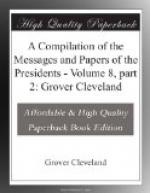That part of this line of highlands which lies east of the sources of the Rimouski fulfills to the letter the words of the royal proclamation of 1763 and the contemporaneous commission of Governor Wilmot. The first of those instruments defines the mouth of the river St. Lawrence by a line drawn from Cape Rozier to the St. John River (on the Labrador coast), and therefore all to the eastward of that line is “the sea.” The height of land thus traced by the commission, rising from the north shore of the Bay des Chaleurs at its western extremity, divides waters which fall into the river St. Lawrence from those which fall into the sea, and is the southern boundary of the Province established by the proclamation of 1763 under the name of Quebec. The identity of the line defined in the proclamation of 1763 and the boundary of the United States in the treaty of 1783 has been uniformly maintained on the part of the United States, and is not merely admitted but strenuously argued for in the report of Messrs. Featherstonhaugh and Mudge.
The undersigned therefore report that they have explored and in a great measure surveyed and leveled a line of highlands in which the northwest angle of Nova Scotia lies, and which in their opinion is the true boundary between the States of Maine and New Hampshire and the British Provinces.
II.—EXAMINATION OF THE ARGUMENT CONTAINED IN THE REPORT OF MESSRS. MUDGE AND FEATHERSTONHAUGH.
The progress which has been made in the first portion of the duties of the commissioners has been set forth in the preceding part of this report.
Although, as will be there seen, the task of running the meridian line of the monument marking the source of the St. Croix and of exploring and surveying the lines of highlands respectively claimed by the Governments of the United States and Great Britain has not been completed, yet enough has been done to furnish materials for an examination of the argument preferred by Messrs. Mudge and Featherstonhaugh in support of the novel form in which the claim of Great Britain has been presented by them.
In the surveys made by direction of the commissioners under the fifth article of the treaty of Ghent the difficult character of the country had prevented any other method of exploration than that of ascending rivers to their sources. It was believed on the part of the United States that the determination of the position of these sources was sufficient for the demarcation of the line of highlands in relation to which the controversy exists, and no attempt was made to meet the British argument by the exhibition of the fact that the lines joining these sources run in some cases along ridges and in other cases pass over elevations to which in any sense of the term the epithet of “highlands” may be justly applied. The denial of this mode of determining the line of highlands by Great Britain has made it important that




